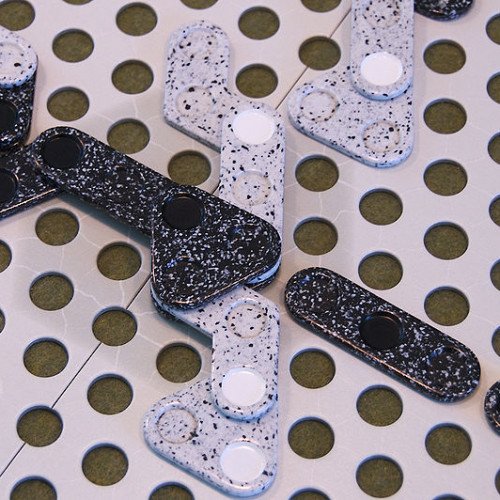PÜNCT VS TAK

PÜNCT
PÜNCT is a two-player strategy board game. It is the sixth (and final) release in the GIPF project of six abstract strategy games, although it is considered the fifth game in the project. It was released in 2005. PÜNCT won the Games Magazine Best Abstract Strategy game for 2007. The PÜNCT board game is one of six games a part of the GIPF project. This project was created by Kris Burm and is a series of six abstract games. PÜNCT is the 5th game of the project and the board of this game is shaped like a hexagon. This game was released in 2005.[citation needed] PÜNCT is a two-player connection game. The objective is to connect two sides of a hexagonal board, using pieces which cover three hexes each. The pieces can be placed, moved, rotated, and stacked in various ways, restricted by the geometry of the board, the shape of the pieces, and gravity. Players can bring new pieces to the board or can attempt to connect the pieces already in play. The objective of the game is to mislead the opponent. When the players take their first turn, they are not able to use the central hexagon. The PÜNCT piece is used as a point of reference throughout the game, but the PÜNCT piece can't be moved when the player is making a move. Minor dots can land on the other player's piece, but the PÜNCT piece may not. In order to make a move, three dots must be in perfect alignment. The pieces that are on top of all of the other pieces have the most power in this game. The dots on the ends of the pieces must be at the same level horizontally to play this game correctly. In order to make a bridge in this game, you must perform a jump move on a piece already on the board. The positions of the dots at the end don't have to be aligned with the middle or stable horizontally. When determining the winner, a player can lift one piece at a time to determine if a connection was made. To connect opposite sides in this game, players can move pieces on top of other pieces or they can stack pieces to block the opponent's connection, ergo, making a connection for themselves. The actual PÜNCT piece, which is a rounded piece that has one point, cannot be used to make a connection or form a “chain” but rather used as a point of reference.
Statistics for this Xoptio

TAK
Tak is a two-player abstract strategy game designed by James Ernest and Patrick Rothfuss and published by Cheapass Games in 2016. The goal of Tak is to be the first to connect two opposite edges of the board with pieces called "stones", and create a road. To accomplish this, players take turns placing their own stones and building a road while blocking and capturing their opponent's stones to hinder their efforts at the same. A player "captures" a stone by stacking one of their pieces on top of the opponent's. These stacks can then be moved as a whole or broken up and moved across several spaces on the board. The vertical stacking and unstacking of stones gives a three dimensional element to the game play. A player may move a single piece or a stack of pieces they control. A stack is made when a player moves a stone on top of another flat stone of any color. The stone on top of a stack determines which player has control of that entire stack. All stones move orthogonally in a straight line on the board. There is no diagonal movement. A player can also move a whole stack in addition to single stones. A stack can be moved like a single stone, moved in its entirety one space orthogonally (North, South, East, or West), or it can move several spaces orthogonally by breaking the stack and placing one or more flat stones onto the squares being moved onto. The player can leave any number of stones, including zero, on the starting space, but must place at least one piece for each subsequent move. There is no height limit for stacks, but the amount of stones a player can remove from the stack and move is set by the "carry limit" of the board. The carry limit of the board is determined by the dimensions of the board. For example, if the stack was on a 5x5 board, the carry limit of the stack would be five. Because standing stones and capstones can't be stacked upon, there are no stacks with these pieces at the bottom or in the middle of the stack. Both of these stones however can be moved onto other flat stones to form a stack with them as the head. A capstone may "flatten" a standing stone and use it to form a stack with the capstone as its head, but it must do so alone. For example, a stack with a capstone cannot flatten a standing stone by moving as a stack onto the standing stone, but a stack can be used to move a capstone across the board so that the capstone alone moves to flatten the standing stone as the final movement.